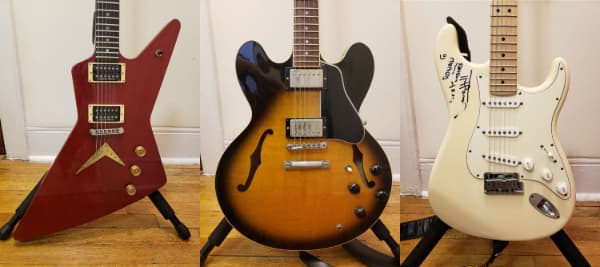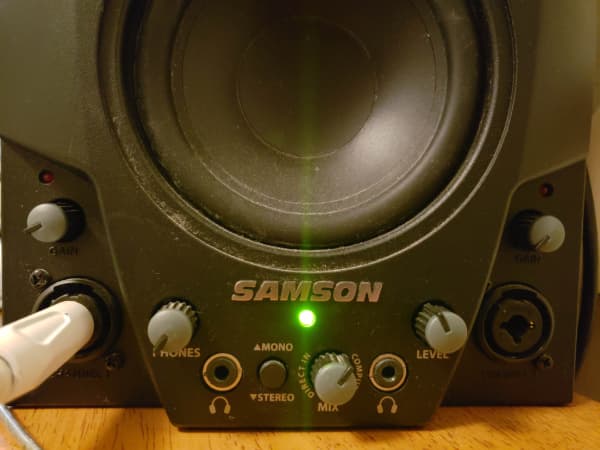If you’re a guitarist and you’ve been playing a while, there’s a good chance you have a few at home. Following that, you’ve probably had at least one person ask, “Why do you have so many guitars?”
In this post, we’ll look at why you need different guitars, and the kinds of guitar you should have available to you. We’ll focus on electric guitars.
The next time somebody asks why you have so many guitars, you can just send them a link to this post!
Why so many guitars?: rig run down
Here’s a run down of the gear I used to put this demonstration together.
- ASUS Chromebook Flip C100PA
- Samson Studio GT monitors
- Beyerdynamic DT-100 headphones
- 1996 Dean USA Z
- 1996 Gibson ES-335
- 2007 Fender American Standard Stratocaster
- Hotone Tuner
- Pig Hog guitar cables
- Jim Dunlop Gator Grip 1.14mm picks
- Electric guitar strings: Ernie Ball Regular Slinky
Why so many guitars?
The short answer is: they all sound different.
So, in recording, we use different guitars to play different parts in different ways. With the result of a substantial guitar sound. So that’s cool!

The longer answer
The approach focuses on “low on the verse; high on the chorus.”
With this in mind, the guitars – and how and where they’re used – reflect this mantra.
To illustrate, it’s time for a table. Essentially, it’s a whitewashed version of the one describing my process in recording electric guitars for Alroight Bab.
| Solid body with humbuckers |
|
| Semi-hollow body with humbuckers |
|
| Solid body with single coil pickups |
|
Given these points, we can see the specific guitars are used on specific parts of the songs. Further, the specific guitars are played in specific ways.
Because of this, these different guitars are played in different ways that emphasize the “low on the verse; high on the chorus” mantra noted earlier.
In other words, certain guitars do certain things really well because of their base sound. In recording, we work with these base sounds to create dynamics.
To this end, these dynamics keep a song changing, interesting, and aurally engaging for the listener.
Look and listen
To demonstrate even further, here’s a video. In order to keep the guitar sounds comparative, I used each of the type of guitar outlined in the last section’s most middle-gound sound:
- Volume and tone knobs all the way up: because it’s the only sure comparable setting across all three instruments
- Middle single coil pickup or both humbucking pickups: because it’s essentially the “middle” sound of each instrument
- Plugged each guitar directly into the Samson via a trusty Pig Hog cable: because it avoids the variables that might be cause by amplifiers and effects pedals
- Same input level on the Samson for all three guitars: because that’ll show the different output levels of the guitars – an additional factor that needs to be managed in recording electric guitars

Now that we’ve established an approach to recording the guitars in a comparative way that’ll highlight their differences, here’s a bit about the video itself.
The video doesn’t use any particular song. It’s just a simple 4/4 rhythm at 130 bpm, with a random, generic G, C, D strum-along.
The audio was recorded and edited in BandLab. In like manner to the raw input, no effects or anything were added in recording. Not even any compression. Then, in exporting the audio, I used BandLab’s standard CD quality mastering option.
Because we’re working on a Chromebook and we’re on a budget, I Googled an online, in-browser video editor – essentially looking a video equivalent to BandLab.
One of the top results was a website called clipchamp, which looked like it would do the job. It absolutely did, and for a free resource, I was very impressed.
And now, for our feature presentation!
Conclusion
Hopefully, this will clear up questions about the number of guitars in somebody’s possession or on a record.
Remember, although it’s convenient to have a variety of guitars, it’s not always feasible, in terms of budget or space. In these cases, you can make friends with people who have the guitars you need, or look into renting instruments.
To summarize, I don’t know how to explain the matter any clearer!
If you found this helpful, subscribe on the right hand side of this page. You’ll be notified when new posts go live on Thursdays, inspiring you going into the weekend.
Share your own light audio recording thoughts and experiences! There’s a Facebook group, a Subreddit, Twitter and Instagram.
Also, feel free to shoot me a coffee!